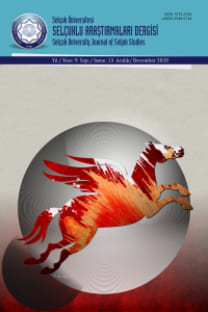MYRİOKEPHALON ZAFERİ ÖNCESİNDE KONYA’YI HEDEF ALAN ASKERÎ SEFERLER VE YOLLARI
Friedrich Barbarossa, Manuel Komnenos, Myriokephalon, I. Mesud, Konya, II. Kılıç Arslan
MILITARY EXPEDITIONS AND THEIR ROUTES TO KONYA PRIOR TO THE MYRIOKEPHALON VICTORY
Friedrich Barbarossa, Manuel Komnenos, Myriokephalon, Mesud I, Konya, Kilij Arslan II,
___
- Kaynak Eserler
- Anna Komnene, Alexiade, Regne de Tempereur Alexis I Comnene (1081-1118), (nşr. ve trc. B. Leib), Paris 1937-45,1-III, (İng. Elizabeth
- A. S. Dawes), The Alexiad, London 1928, (trc. Bilge Umar) Alexiad Malazgirt’in Sonrası, İstanbul 1996.
- Anonim Selçuknâme, (nşr. ve trc. Feridun Nafiz Uzluk), Ankara 1952.
- Ebu’l-Ferec (Bar Hebraeus), Abû’l-Farac Tarihi, (çev. Ömer Rıza Doğrul), Ankara 1987, II.
- Kinnamos, Ioannes, Epitome Historiarum, CSHB, (nşr. I. Meinecke), Bonn 1836, (Frs. J. Rosenblum), Chronique, Paris 1972; Ioannes Kinnamos’un Historia’sı, (çev. Işın Demirkent), Ankara 2001.
- Kumandan Simbat, Vekayinâme, (trc. Hrant D. Andreasyan), çeviri nr. 68, (TTK’da henüz yayımlanmamış tercüme).
- Niketas Khoniates, Historia, (çev. Fikret Işıltan), Ankara 1995.
- Odo de Deuil, De Profectione Ludovici VII in Orientem, (trc. V. G. Berry), New York 1948. S üryanî Mikhail, Khronik, (nşr. ve trc. J. B. Chabot), Chronique de Michel le Syrien, Patriarche jacobite d’Antioche (1116-99), Paris 1899-1924, (trc. Hrant D. Andreasyan), Süryani Patrik Mihail’in Vekayinâmesi 1042-1195, Ankara 1944, II, (TTK’da henüz yayımlanmamış tercüme).
- Araştırma Eserleri
- Ceylan, M. Akif-Adnan Eskikurt, Tarihî Coğrafya Açısından Myrikephalon Savaşı ve Konya Bağırsak Boğazı, Konya 2017.
- Chalandon, Ferdinand, Alexis Comnene: Les Comnene, Jean II Comnene et Manuel I Comnene, Paris 1910-1912, I-II.
- Çay, Abdülhaluk, II. Kılıç Arslan, Ankara 1987.
- -----------------------, Anadolu’nun Türkleşmesinde Dönüm Noktası Sultan II. Kılıç Arslan ve Karamıkbeli (Myriokephalon) Zaferi, İstanbul 1984.
- Demirkent, Işın, Haçlı Seferleri, İstanbul 1997.
- __________, “Komnenos Hanedanının Büyük Başkumandanı: Türk Asıllı Ioannes Aksukhos”, Belleten, Ankara 1996, c. LX, sa. 227.
- Eskikurt, Adnan - Mehmet Akif Ceylan, Selçuklu-Bizans Münasebetlerinde Bir Dönüm Noktası Myriokephalon Zaferi (Beyşehir-Bağırsak Boğazı-Miryokefalon) 17 Eylül 1176, İstanbul 2015.
- Kesik, Muharrem, Türkiye Selçuklu Devleti Tarihi Sultan I. Mesud Dönemi (1116-1155), Ankara 2003.
- Moravcsik, Gyula, Byzantinoturcica, Leiden 1983, I-II.
- Ramsay, William Mitchell, The Historical Geography of Asia Minor, (çev. Mihri Pektaş), Anadolu’nun Tarihî Coğrafyası, İstanbul 1961.
- Runciman, Steven, Haçlı Seferleri Tarihi, (çev. Fikret Işıltan), Ankara 1992, II.
- Turan, Osman, Selçuklular Zamanında Türkiye, İstanbul 1993.
- Umar, Bilge, Türkiye’deki Tarihsel Adlar,İstanbul 1993.
- Vasiliev, A. Alexandrovich, “Manuel Comnenos and Henry Plantagenet”, Byzantinische Zeitschrift, band , XXIX, Leipzig und Berlin 1929-30, s. 233-244.
- ISSN: 1015-2105
- Yayın Aralığı: Yılda 2 Sayı
- Başlangıç: 1986
- Yayıncı: Selçuk Üniversitesi
BAĞIRSAK BOĞAZI (KONYA) VE YAKIN ÇEVRESİNDE BEŞERİ COĞRAFYA ARAŞTIRMALARI
MİRYOKEFALON MUHAREBESİ’NİN MAHALLİ ÜZERİNE MÜLAHAZALAR: BİZANS KAYNAKLARI
Levent KAYAPINAR, Beycan HOCAOĞLU, Serdar VARDAR, Mahmut Halef CEVRİOĞLU
PİSİDİA ANTİOKHEİASI, YOLLAR VE MİRYOKEFALON SAVAŞI
MYRİOKEPHALON MUHAREBESİ’NİN MEVKİSİ ÜZERİNE
MYRİOKEPHALON SAVAŞI’NIN KONYA BAĞIRSAK BOĞAZI’NA LOKALİZE EDİLMESİNE MİKROTOPONİMİK KATKILAR
TARİH ÖNCESİNDEN BİZANS DÖNEMİNE KADAR KONYA ULAŞIMI VE BALKAYALAR-BAĞIRSIKDERE KALESİ
MYRİOKEPHALON ZAFERİ ÖNCESİNDE KONYA’YI HEDEF ALAN ASKERÎ SEFERLER VE YOLLARI
MYRİOKEPHALON SAVAŞI (17 EYLÜL 1176) AÇISINDAN KONYA BAĞIRSAK BOĞAZI’NIN COĞRAFİ ÖZELLİKLERİ
BAĞIRSAK BOĞAZI VE ÇEVRESİNİN (KONYA) FİZİKİ COĞRAFYA ÖZELLİKLERİ
